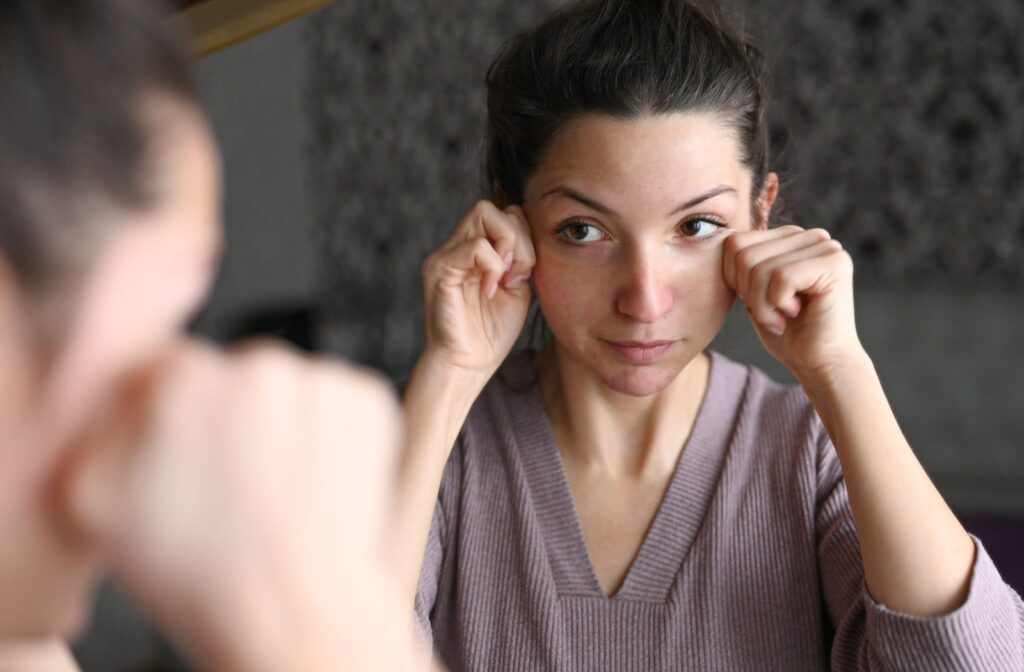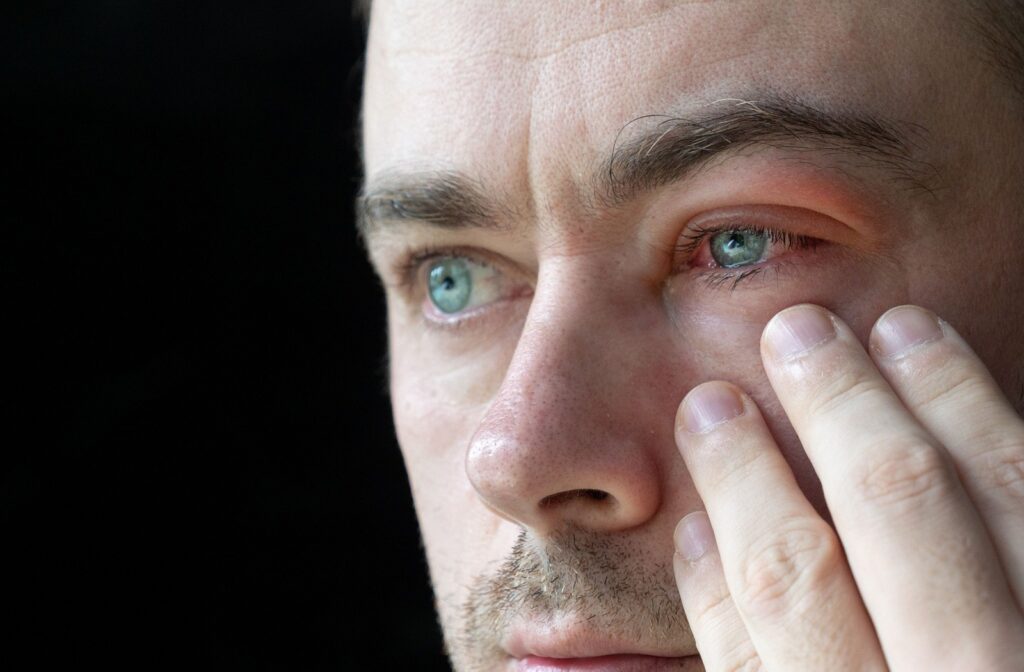While both blepharitis and pink eye cause eye irritation and redness, blepharitis affects your eyelids and tends to be chronic, whereas pink eye affects the clear membrane covering your eye and is often temporary but contagious. A comprehensive eye exam can help identify the cause of your discomfort.
Whether you’re dealing with morning eye redness or persistent discomfort, understanding these conditions is crucial for finding relief.
What You Need to Know About These Common Eye Conditions
Both blepharitis and conjunctivitis (pink eye) can make your eyes feel uncomfortable and cause them to become red or swollen. However, each of these conditions affects different parts of your eye. They also have distinct causes that require different approaches to treatment.
Both conditions can be treated, but the timeline and treatment methods vary significantly.
Blepharitis: When Your Eyelids Get Inflamed
Blepharitis happens when the edges of your eyelids become inflamed, creating uncomfortable symptoms that can affect your daily routine. This condition typically develops gradually and can affect people of all ages, though it becomes more common as you get older.
What Blepharitis Looks Like
Blepharitis has several common symptoms. They often appear together and can vary in intensity. They include:
- Red and swollen eyelids
- Crusty or flaky debris around eyelashes
- Burning or gritty sensation
- Sticky eyelids in the morning
- Light sensitivity
What Causes Blepharitis
Several factors can contribute to blepharitis. Your oil glands, bacteria levels, and overall eyelid hygiene all play important roles in this condition.
- Clogged oil glands in eyelids
- Bacterial overgrowth
- Skin conditions like dandruff or rosacea
- Poor eyelid hygiene
How Long Blepharitis Lasts
Blepharitis tends to be a chronic condition. It comes and goes over time. You might experience flare-ups during stressful periods or when your eyelid hygiene routine slips. This condition often coincides with meibomian gland dysfunction, which affects the oil-producing glands in your eyelids.
Many people find that consistent daily care helps manage symptoms effectively. Your optometrist can advise you on treatment methods.
Pink Eye: When the Eye Surface Gets Infected
Pink eye, also called conjunctivitis, affects the thin, clear membrane that covers the white part of your eye and lines your inner eyelids. Pink eye can develop quickly and often spreads easily between family members.
What Pink Eye Looks Like
Pink eye symptoms tend to appear suddenly and can affect one or both eyes. The distinctive redness gives this condition its common name.
- Red or bloodshot eyes
- Watery or thick discharge
- Itching and burning sensation
- Eyes sticking together after sleep
- Blurred vision
3 Main Types of Pink Eye
Each type of pink eye has different causes and treatment approaches. Identifying which type you have helps determine the right care plan and whether the condition is contagious.
- Viral pink eye, from cold viruses
- Bacterial pink eye, caused by bacterial infection
- Allergic pink eye, caused by allergens
How Pink Eye Spreads
Viral and bacterial pink eye spread easily through contact with infected eye secretions. Common vectors of infection include sharing towels and pillowcases, or touching contaminated surfaces.
Allergic pink eye doesn’t spread from person to person, since it’s your body’s reaction to specific triggers like pollen or pet dander. This form of the condition often affects both eyes and may coincide with light sensitivity.
Key Differences Between Blepharitis & Pink Eye
While both conditions affect your eyes, they target different areas and behave in distinct ways. Recognizing these differences helps you respond appropriately to your symptoms.
Where the Problem Happens
Blepharitis primarily affects your eyelid margins where your eyelashes grow, causing inflammation and irritation along the edges. Pink eye targets the conjunctiva—the clear membrane that covers your eyeball and inner eyelids.
You can think of blepharitis as an “outside” problem affecting your eyelid skin, while pink eye is more of an “inside” issue affecting the eye’s surface. This location difference explains why the symptoms and treatments vary between these conditions.
Type of Discharge You’ll See
Blepharitis typically produces crusty, flaky debris that accumulates around your eyelashes, especially after sleeping. This material often looks like dandruff and can be yellow or white in color.
Pink eye creates liquid discharge that can range from clear and watery to thick and colored, depending on the type. Bacterial pink eye often produces yellow or green discharge, while viral and allergic types tend to be more watery.
Is It Contagious?
Blepharitis is not contagious, so you don’t need to worry about spreading it to family members or friends. You can share towels and cosmetics without concern for transmission.
On the other hand, viral and bacterial forms of pink eye are highly contagious. You’ll need to take precautions like using separate towels and washing your hands frequently to protect others from infection.
Treatment Options for Each Condition

Both conditions respond well to appropriate treatment, though the approaches differ based on the underlying cause. You can often start with home care, but professional treatment may be necessary for persistent or severe symptoms.
How to Treat Blepharitis at Home
Daily eyelid hygiene forms the foundation of blepharitis management. These simple steps can help reduce inflammation and prevent flare-ups, similar to warm compress treatments for other eye conditions.
- Warm compresses twice daily
- Gentle eyelid cleaning
- Remove eye makeup completely
When Blepharitis Needs Professional Care
Sometimes home care isn’t enough to control blepharitis symptoms effectively. Your eye doctor can prescribe antibiotic ointments or recommend treatments like intense pulsed light therapy.
Professional treatment becomes important when symptoms interfere with your daily activities or when simple home remedies don’t provide adequate relief.
Pink Eye Treatment by Type
Treatment depends on what’s causing your pink eye. Each type requires a different approach for effective relief and proper healing.
- Viral: supportive care and cold compresses
- Bacterial: antibiotic eye drops
- Allergic: antihistamine drops and allergen avoidance
When to See an Eye Doctor in Westlake
While many eye irritations resolve on their own, certain symptoms signal the need for professional evaluation. Your optometrist can provide accurate diagnosis and effective treatment to get you back to comfortable vision through comprehensive eye examinations.
Red Flags That Need Immediate Attention
Some symptoms indicate potential eye emergencies. If you experience any of these, seek immediate medical attention:
- Severe pain or vision changes
- Symptoms lasting more than a week
- Thick yellow or green discharge
- Light sensitivity with headaches
How Your Optometrist in Westlake Can Help
Professional eye care provides accurate diagnosis and targeted treatment for both blepharitis and pink eye. Your eye doctor can distinguish between these conditions and create a personalized treatment plan using modern diagnostic technology.
At our optical boutique, we also offer premium eyewear and handcrafted frames to support your eye health while keeping you looking great. We combine high-tech diagnostic tools with personalized care to address your specific needs.
What to Expect During Your Eye Exam
Your eye exam includes a detailed evaluation of your symptoms, medical history, and current eye health. We’ll examine your eyelids, eye surface, and surrounding tissues to determine the exact cause of your discomfort.
This thorough approach helps us provide the most effective treatment recommendations. You’ll leave with a clear understanding of your condition and practical steps for relief.
Prevention Tips for Both Conditions
Good eye hygiene habits can help prevent the development or recurrence of blepharitis and pink eye.
Daily Habits That Protect Your Eyes
Consistent hygiene practices form your first line of defense against eye irritation. Here are a couple important factors:
- Proper hand hygiene
- Clean makeup removal
- Replacing eye cosmetics regularly
- Avoiding touching or rubbing eyes
Special Care for Contact Lens Wearers
Contact lens users need extra attention to prevent eye infections and irritation. Proper lens hygiene and replacement schedules help maintain healthy eyes while enjoying clear vision through appropriate contact lens care.
Always wash your hands before handling lenses, and follow your eye care professional’s recommendations for cleaning and replacement. Remove your contacts immediately if you develop any signs of eye irritation or infection, and consider following guidelines for proper contact lens maintenance.
If you’re experiencing eye irritation, discharge, or discomfort, don’t wait to get the care you need. At Eyes on Westlake, our team provides comprehensive eye exams and personalized treatment to help you achieve comfortable, healthy vision. Contact us today to schedule your appointment and get back to feeling your finest.




